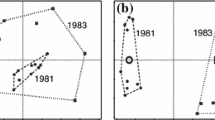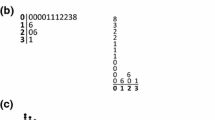Abstract
Simulated vegetation data were used to assess the relative robustness of ordination techniques to variations in the model of community variation in relation to environment. The methods compared were local nonmetric multidimensional scaling (LNMDS), detrended correspondence analysis (DCA), Gaussian ordination (GO), principal components analysis (PCA) and principal co-ordinates analysis (PCoA). Both LNMDS and PCoA were applied to a matrix of Bray-Curtis coefficients. The results clearly demonstrated the ineffectiveness of the linear techniques (PCA, PCoA), due to curvilinear distortion. Gaussian ordination proved very sensitive to noise and was not robust to marked departures from a symmetric, unimodal response model. The currently popular method of DCA displayed a lack of robustness to variations in the response model and the sampling pattern. Furthermore, DCA ordinations of two-dimensional models often exhibited marked distortions, even when response surfaces were unimodal and symmetric. LNMDS is recommended as a robust technique for indirect gradient analysis, which deserves more widespread use by community ecologists.
Similar content being viewed by others
References
Austin M. P., 1976. Performance of four ordination techniques assuming different non-linear species response models. Vegetatio 33: 43–49.
Austin M. P., 1980. Searching for a model for use in vegetation analysis. Vegetatio 42: 11–21.
Austin M. P., 1985. Continuum concept, ordination methods and niche theory. Ann. Rev. Ecol. Syst. 16: 39–61.
Austin M. P., 1987. Models for the analysis of species' response to environmental gradients. Vegetatio 69: 35–45.
Austin M. P., Cunningham R. B. & Fleming P. M., 1984. New approaches to direct gradient analysis using environmental scalars and statistical curve-fitting procedures. Vegetatio 55: 11–27.
Austin M. P. & Noy-Meir I., 1971. The problem of nonlinearity in ordination: experiments with two-gradient models. J. Ecol. 59: 763–773.
Beatty S. W., 1984. Influence of microtopography and canopy species on spatial patterns of forest understorey plants. Ecology 65: 1406–1419.
Bradfield G. E. & Scagel A., 1984. Correlations among vegetation strata and environmental variables in subalpine sprucefir forests — southeast British Columbia. Vegetatio 55: 105–114.
Brown M. J., Ratkowsky D. A. & Minchin P. R., 1984. A comparison of detrended correspondence analysis and principal co-ordinates analysis using four sets of Tasmanian vegetation data. Aust. J. Ecol. 9: 273–279.
Chardy P., Glemarec M. & Laurec A., 1976. Application of inertia methods to benthic marine ecology: practical implications of the basic options. Estuar. Coast. Mar. Sci. 4: 179–205.
Clymo R. S., 1980. Preliminary survey of the peat-bog Hummell Knowe Moss using various numerical methods. Vegetatio 42: 129–148.
Dargie T. C. D., 1984. On the integrated interpretation of indirect site ordinations: a case study using semi-arid vegetation in southeastern Spain. Vegetatio 55: 37–55.
DelMoral R., 1980. On selecting indirect ordination methods. Vegetatio 42: 75–84.
Faith D. P., Minchin P. R. & Belbin L., 1987. Compositional dissimilarity as a robust measure of ecological distance. Vegetatio 69: 57–68.
Fasham M. J. R., 1977. A comparison of nonmetric multidimensional scaling, principal components analysis and reciprocal averaging for the ordination of simulated coenoclines and coenoplanes. Ecology 58: 551–561.
Feoli E. & Feoli Chiapella L., 1980. Evaluation of ordination methods through simulated coenoclines: some comments. Vegetatio 42: 35–41.
Fewster P. H. & Orlóci L., 1983. On choosing a resemblance measure for non-linear predictive ordination. Vegetatio 54: 27–35.
Field J. G., Clarke K. R. & Warwick R. M., 1982. A practical strategy for analysing multispecies distribution patterns. Mar. Ecol. Prog. Ser. 8: 37–52.
Gauch H. G., 1973. The relationship between sample similarity and ecological distance. Ecology 54: 618–622.
Gauch H. G., 1979. Catalog of the Cornell ecology programs series. 11th ed. Ecology and Systematics, Cornell University, Ithaca, New York.
Gauch H. G., 1982. Multivariate analysis in community ecology. Cambridge University Press, London and New York.
Gauch H. G., Chase G. B. & Whittaker R. H., 1974. Ordination of vegetation samples by Gaussian species distributions. Ecology 55: 1382–1390.
Gauch H. G. & Whittaker R. H., 1972a. Coenocline simulation. Ecology 53: 446–451.
Gauch H. G. & Whittaker R. H., 1972b. Comparison of ordination techniques. Ecology 53: 868–875.
Gauch H. G. & Whittaker R. H., 1976. Simulation of community patterns. Vegetatio 33: 13–16.
Gauch H. G., Whittaker R. H. & Singer S. B., 1981. A comparative study of nonmetric ordinations. J. Ecol. 69: 135–152.
Gibson N. & Kirkpatrick J. B., 1985. Vegetation and flora associated with localised snow accumulation at Mount Field West, Tasmania. Aust. J. Ecol. 10: 91–99.
Goodall D. W. & Johnson R. W., 1982. Non-linear ordination in several dimensions. A maximum likelihood approach. Vegetatio 48: 197–208.
Gower J. C., 1966. Some distance properties of latent root and vector methods used in multivariate analysis. Biometrika 53: 325–338.
Greig-Smith P., 1980. The development of numerical classification and ordination. Vegetatio 42: 1–9.
Greig-Smith P., 1983. Quantitative plant ecology. 3rd ed. Blackwell, Oxford.
Hill M. O., 1979. DECORANA — A FORTRAN Program for Detrended Correspondence Analysis and Reciprocal Averaging. Ecology and Systematics, Cornell University, Ithaca, New York.
Hill M. O. & Gauch H. G., 1980. Detrended correspondence analysis, an improved ordination technique. Vegetatio 42: 47–58.
Hotelling H., 1933. Analysis of a complex of statistical variables into principal components. J. Ed. Psych. 24: 417–441 & 498–520.
Ihm P. & VanGroenewoud H., 1975. A multivariate ordering of vegetation data based on Gaussian type gradient response curves. J. Ecol. 63: 767–777.
Johnson R. W. & Goodall D. W., 1979. Maximum likelihood approach to non-linear ordination. Vegetatio 41: 133–142.
Kruskal J. B., 1964a. Multidimensional scaling by optimizing goodness of fit to a nonmetric hypothesis. Psychometrika 29: 1–27.
Kruskal J. B., 1964b. Nonmetric multidimensional scaling: a numerical method. Psychometrika 29: 115–129.
Loucks O. L., 1962. Ordinating forest communities by means of environmental scalars and phytosociological indices. Ecol. Monogr. 32: 137–166.
Minchin, P. R., 1983. A comparative evaluation of techniques for ecological ordination using simulated vegetation data and an integrated ordination-classification analysis of the alpine and subalpine plant communities of the Mt Field Plateau, Tasmania. Ph.D. thesis, University of Tasmania.
Minchin, P. R., 1987. Simulation of multidimensional community patterns: towards a comprehensive model. Vegetatio (in press).
Mohler C. L., 1981. Effects of sample distribution along gradients on eigenvector ordination. Vegetatio 45: 141–145.
Noy-Meir I. & Austin M. P., 1970. Principal-component ordination and simulated vegetational data. Ecology 51: 551–552.
Oksanen J., 1983. Ordination of boreal heath-like vegetation with principal component analysis, correspondence analysis and multidimensional scaling. Vegetatio 52: 181–189.
Orlóci L., 1974. On information flow in ordination. Vegetatio 29: 11–16.
Orlóci L., 1978. Multivariate analysis in vegetation research. 2nd ed. Junk, The Hague.
Orlóci L., 1980. An algorithm for predictive ordination. Vegetatio 42 23–25.
Orlóci L., Kenkel N. C. & Fewster P. H., 1984. Probing simulated vegetation data for complex trends by linear and nonlinear ordination methods. Abstr. Bot. 8: 163–172.
Prentice I. C., 1977. Non-metric ordination methods in ecology. J. Ecol. 65: 85–94.
Prentice I. C., 1980. Vegetation analysis and order invariant gradient models. Vegetatio 42: 27–34.
Robertson P. A., MacKenzie M. D. & Elliot L. F., 1984. Gradient analysis and classification of the woody vegetation for four sites in southern Illinois and adjacent Missouri. Vegetatio 58: 87–104.
Rotenberry J. T. & Wiens J. A., 1980. Habitat structure, patchiness and avian communities in North American steppe vegetation: a multivariate analysis. Ecology 61: 1228–1250.
Schönemann P. H. & Carroll R. M., 1970. Fitting one matrix to another under choice of a central dilation and a rigid motion. Psychometrika 35: 245–255.
Sibson R., 1972. Order invariant methods for data analysis. J. Roy. Statist. Soc. B. 34: 311–349.
Swan J. M. A., 1970. An examination of some ordination problems by use of simulated vegetational data. Ecology 51: 89–102.
Van derMaarel E., 1980. On the interpretability of ordination diagrams. Vegetatio 42: 43–45.
Van derMaarel E., Boot R., VanDorp D. & Rijntjes J., 1985. Vegetation succession on the dunes near Oostvoorne, The Netherlands; a comparison of the vegetation in 1959 and 1980. Vegetatio 58: 137–187.
Walker J. & Peet R. K., 1983. Composition and species diversity of pine-wiregrass savannas of the Green Swamp, North Carolina. Vegetatio 55: 163–179.
Whittaker R. H., 1960. Vegetation of the Siskiyou Mountains, Oregon and California. Ecol. Monogr. 30: 279–338.
Whittaker R. H., 1967. Gradient analysis of vegetation. Biol. Rev. 42: 207–264.
Whittaker R. H. & Gauch H. G., 1978. Evaluation of ordination techniques. In: R. H.Whittaker (ed.), Ordination of plant communities, pp. 227–336. Junk, The Hague.
Young, F. W. & Lewyckyj, R., 1979. ALSCAL-4 User's Guide. Data Analysis and Theory Associates, P.O. Box 446, Carrboro, North Carolina.
Author information
Authors and Affiliations
Additional information
I acknowledge the encouragement of Dr M. P. Austin and Dr B. M. Potts and the co-operation of the staff of the University of Tasmania computing centre. I also thank Prof. R. S. Clymo, Dr I. C. Prentice and Prof. L. Orlóci for helpful comments on the manuscript. This work formed part of a Ph.D. project at the Botany Department, University of Tasmania, during which I held an Australian Commonwealth Postgraduate Research Award.
Rights and permissions
About this article
Cite this article
Minchin, P.R. An evaluation of the relative robustness of techniques for ecological ordination. Vegetatio 69, 89–107 (1987). https://doi.org/10.1007/BF00038690
Accepted:
Issue Date:
DOI: https://doi.org/10.1007/BF00038690




